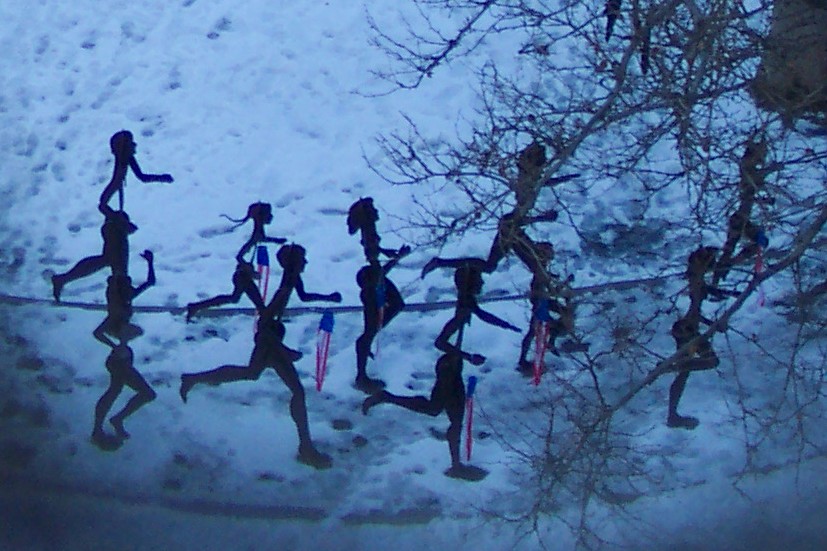WALK

Usage: While we walk on our hind limbs to commute from point
A to point B, the manner and style of our gait
(e.g., marching, mincing, or swaggering) telegraphs
information about our status, feelings, and moods. Our
bipedal walk's two-point rhythm provides the neurological foundation for
a. music's syncopated beat, and b. the
oscillating movements of dance.
Anthropology. A bipedal stride
enabled our human ancestors to cover great distances on African grasslands ca. three m.y.a. Survival required that they
stay continually on the move (Devine 1985). The earliest physical
evidence for human-style walking dates back 3.5 m.y.a. to the tracks of three
upright ancients (probably australopithecines) who strolled across a bed of
fresh volcanic ash one day on the east-African savannah, in what is now Laetoli,
Tanzania. The footprints are nearly identical to those of modern humans, only
smaller.
Evolution. Our legs originated ca. 400 m.y.a. from the lobe
fins of Devonian fishes resembling crossopterygians.
Media I. "I am in the moment, living the experience,
when I am walking." --Joy Jones ("Meaningful Steps," Washington Post, p. D5, September 11, 1992).
Media II. The scariest movie monsters walk upright like human beings. Their resemblance to people renders them even more terrible than ordinary land (i.e., quadrupedal), air, and sea monsters. Bipedal dynosaurs (e.g., Velociraptor and Tyrannosaurus in the 1993 movie Jurassic Park), insectoids (Aliens, 1996), and primates (King Kong, 1933) resonate with horrific images of the upright human form.
Pediatrics. Babies begin advancing one limb at a time on all fours between the 6th and 9th months of life, to crawl for the sheer pleasure of movement (Chase and Rubin 1979). Infants are born with two walking reflexes. The plantar reflex causes an infant's lower limbs to contract the extensor muscles when their feet touch a horizontal surface. Held under the arms, a baby can support its own weight and take several steps forward. The plantar reflex lasts for two months, and is not present in all infants. When a baby's leg touches the side of a flat surface, it will automatically lift its leg and place its foot on the horizontal plane. This, the tactile placing reflex, is also present in many other terrestrial vertebrates.
Philosophy I. Followers of Aristotle (384-322 BC), who founded the Lyceum in 335 BC, were known as peripatetics because they walked and underwent "restless practices" (Flew 1979:265) as they thought and shared ideas, rather than merely sitting in place.
Philosophy II. The two-point rhythm of
walking's stride clears the mind for thinking. (N.B.:
Perhaps, after telling the spinal circuits to "take a walk," the forebrain
shifts to automatic pilot, so to speak, freeing the neocortex to ponder
important issues of the day.) Many philosophers were lifetime walkers, who found
that bipedal rhythms facilitated creative contemplation and thought. In
his short life, e.g., Henry David Thoreau walked an estimated 250,000 miles--ten
times the circumference of earth.
U.S. politics. "The black-footed
species [of Pacific albatross, nicknamed "gooney bird"] . . . has a more
distinctive walk--head down and clavicles hunched like shoulders. 'After
[Richard Milhous] Nixon
visited here [Midway Island] during Vietnam, the black-footed species'
distinctive method of walking suddenly looked familiar,' says [U.S. Fish and
Wildlife manager Rob] Shallenberger. 'Since then, it's been referred to as the
Nixon walk'" (Friend 2000:54).
RESEARCH REPORTS: 1. "The legs of an amphibian served the same function as the inertial force of water for a swimming animal, providing a fulcrum that enabled early amphibians to be little more than fish that swam on land" (Jerison, 1976:11). 2. Basal ganglia initiate movement and ". . . are responsible for the automatic movements we make without thinking" (Restak, 1995:16).
Neuro-notes I. The natural rhythm of our
upright, bipedal gait is coordinated by the same spinal paleocircuits that programmed the oscillatory
swimming motions of the early fishes (Grillner
1996); see PALEOCIRCUIT: CENTRAL PATTERN GENERATOR.
TSK
Neuro-notes II. Something deep in our
vertebrate soul finds walking for its own sake an evolutionary necessity.
Impulses to go on walkabout are coordinated by oscillatory circuits of the
spinal cord, by excitatory centers of the aquatic
midbrain, and by the basal
ganglia of the reptilian
forebrain. (N.B.:
Neurologically, our nonverbal nature lies in movement.)
See also ARM-SWING, GOLF, RAPPORT, SWAGGER-WALK.
Copyright 1998 - 2021 (David B. Givens/Center for
Nonverbal Studies)
Photo of "Runners" (Spokane, Washington, USA) by Doreen K. Givens (copyright 2007)